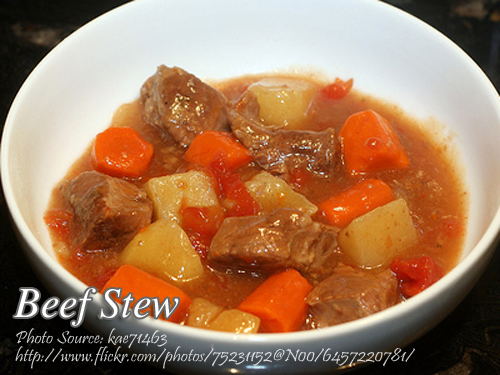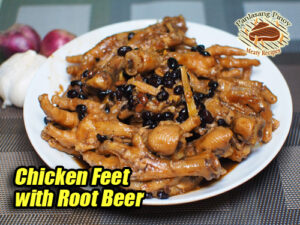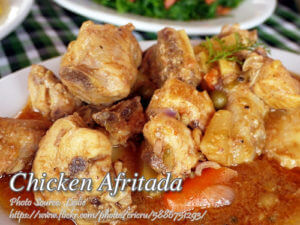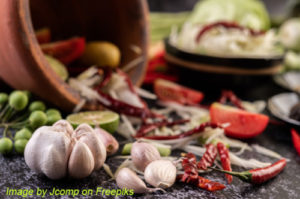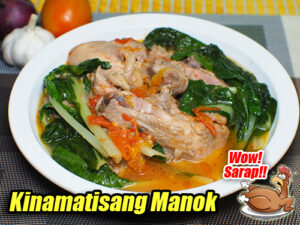Beef stew is a braised beef with root vegetables such as carrots and potatoes. Perfect for cold weather like we are experiencing. Other vegetables includes are sweet peas, celery, sweet pepper and tomatoes. This dish is very similar to mechado or kaldereta and come to think of it, maybe those dishes comes from the world renowned beef stew.
A Warm Bowl of Nostalgia: Beef Stew Recipe
Beef stew is one of those dishes that feels like a warm hug on a cold day. The rich, hearty flavors of tender beef braised in a savory broth with root vegetables like carrots and potatoes bring comfort like no other. In our family, this dish has been a cold-weather staple for as long as I can remember. My earliest memories of it are tied to Sunday lunches at my Lola Lina’s house in Batangas, where her kitchen smelled of garlic and onions sizzling in oil—a prelude to something magical simmering on the stove.
The Roots of Beef Stew
Before diving into the recipe, let’s talk about the origins of the dish. It’s a dish with global variations, from France’s boeuf bourguignon to the hearty Irish stew. Here in the Philippines, our version bears a striking resemblance to beloved dishes like kaldereta and mechado. Perhaps these Filipino classics were inspired by the world-famous beef stew, adapting it with our local ingredients and flavors. What makes our rendition special is the way we balance bold and savory flavors, creating a meal that feels uniquely Pinoy.
When my cousin Carlo returned from a culinary trip to Ilocos Norte, he shared how some locals added bagoong (fermented shrimp paste) for an umami kick in their stews. While I haven’t tried that twist yet, I always thought it was fascinating how this dish evolves depending on who makes it.
Browning the Beef: A Crucial Step
One of the first techniques you’ll learn when making beef stew is browning the beef. My Tita Emma always stressed the importance of this step, and for good reason. Browning locks in the meat’s juices and builds a deep, caramelized flavor base. When I skipped this step once (thinking it was optional), the stew turned out flat and uninspired—lesson learned!
The trick is to heat the oil in your pan until it’s shimmering and then sear the beef cubes a few at a time. Overcrowding the pan will steam the meat instead of browning it, so patience is key. Trust me, this extra effort is worth it when you taste the depth it brings to the final dish.
Building Layers of Flavor
The beauty of beef stew lies in its slow-cooking process, which gives the ingredients time to meld into a harmonious whole. Once the beef is browned, you remove the excess oil (a tip I picked up from my uncle Tony, who insists on “clean-tasting” stews). Garlic, onions, parsley, and bay leaf are then sautéed until aromatic, filling your kitchen with an irresistible scent.
Adding tomatoes and soy sauce at this stage provides the perfect balance of acidity and saltiness. My sister Ana, who swears by homegrown tomatoes from our backyard, insists they make the stew even sweeter and more vibrant. A gentle simmer allows the beef to soak up all these flavors, slowly transforming it into melt-in-your-mouth tenderness.
The Secret to Perfect Vegetables
Carrots, potatoes, sweet peas, and celery round out the dish, adding sweetness and texture. My brother, who loves experimenting with recipes, sometimes throws in sweet peppers for a hint of smokiness. The key is to add these vegetables toward the end of cooking, so they retain their vibrant colors and don’t turn to mush.
If you’ve ever wondered why your potatoes and carrots sometimes break apart in stews, it’s often because they’ve been overcooked. Keeping an eye on the simmering pot and adding vegetables in stages ensures each ingredient cooks just right.
Thickening the Broth of Beef Stew
A unique touch in this recipe is using breadcrumbs to thicken the broth. It’s a technique my Lola used when she ran out of cornstarch, and it’s stuck with me ever since. The breadcrumbs dissolve into the liquid, giving the stew a silky texture without overpowering its natural flavors. Stirring the broth well at this stage ensures everything blends smoothly, creating that hearty consistency we all love.
If you’re out of breadcrumbs, flour or cornstarch slurry works as a substitute, but there’s something nostalgic about keeping this old-fashioned method alive. It reminds me of how resourceful Filipino cooks are, always finding ways to adapt recipes to what’s available.
Serving Up Comfort
After simmering for a few more minutes, the stew is ready to serve. I love ladling it over steamed white rice or pairing it with crusty bread to soak up the rich, savory broth. There’s something about sitting down to a bowl of this hearty dish that feels like a celebration of family and tradition.
Whether it’s a quiet dinner at home or a gathering of relatives on a rainy day, it brings everyone together. It’s a reminder of simpler times, when food was more than sustenance—it was a way to connect and share stories. So, gather your ingredients, invite your loved ones, and create your own memories around this timeless dish.
Let the rich aroma fill your kitchen and your heart. Happy cooking!
How to Cook Beef Stew
Ingredients
- 1 kilo beef briskets
- 2 Tbsp. cooking oil
- 1 pc large onion diced
- 2 cloves garlic minced
- 1 stalk celery stalk chopped
- 2 pc small carrots cut into cubes
- 2 pcs potatoes cut into cubes
- 1 cup sweet peas
- 1 can tomato sauce
- 1 can sausage sliced
- 1/8 cup raisins
- 1 pcs bay leaf
- 2 pcs red and green sweet pepper cut into strips
- 2 pcs tomatoes coarsely chopped
- 2 Tbsp. soy sauce
- 1/2 tsp. ground black pepper
- 1/2 cup bread crumbs
Instructions
How to cook Beef Stew:
- Heat oil in a saucepan. Brown beef cubes in the oil, a handful at a time.
- Remove oil from the saucepan and bring the beef cubes back in the pan.
- Add in garlic, diced onions, parsley, bay leaf, tomatoes, salt, pepper and soy sauce.
- Bring to a boil and simmer then cover until meat is tender.
- Add the remaining vegetables and simmer again for a few minutes.
- Thicken broth and bread crumbs and stir well until blended.
- Simmer 5 minutes more and adjust the seasoning. Serve hot.
Notes
Cooking Tips:
Brown the Beef for Depth of Flavor
Browning the beef before simmering is essential to building a rich and flavorful base for your stew. This step caramelizes the surface of the meat, locking in juices and creating a savory depth that enhances the entire dish. Avoid overcrowding the pan during browning, as this can cause the beef to steam instead of sear.Add Vegetables at the Right Time
To keep your vegetables from turning mushy, add them during the final stages of cooking. Sturdy veggies like carrots and potatoes can handle a bit more simmering, while delicate ones like sweet peas should be added just before serving. Timing ensures each ingredient retains its texture and flavor, creating a well-balanced stew.Use Breadcrumbs to Thicken the Broth
For a velvety broth, try thickening it with breadcrumbs instead of cornstarch or flour. Breadcrumbs dissolve seamlessly into the stew, adding body without altering the flavor. Stir well after adding them to avoid lumps, and let the stew simmer for a few minutes to achieve the perfect consistency.
